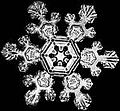Write4U
Valued Senior Member
OK. lets look at the definition of pattern.And physics rule why stuff in space form the shape they do, as well as the way they move (interact) between themselves forming such patterns as they do
Patterns
Is a fractal a physical thing?Any of the senses may directly observe patterns. Conversely, abstract patterns in science,
mathematics, or language may be observable only by analysis. Direct observation in practice means seeing visual patterns, which are widespread in nature and in art. Visual patterns in nature are often chaotic, never exactly repeating, and often involve fractals.
Natural patterns include spirals, meanders, waves, foams, tilings, cracks, and those created by symmetries of rotation and reflection.
https://en.wikipedia.org/wiki/PatternPatterns have an underlying
mathematical structure;[1] indeed, mathematics can be seen as the search for regularities, and the output of any function is a mathematical pattern. Similarly in the sciences, theories explain and predict regularities in the world.
Patterns in Nature
Symmetry (Further information: Symmetry in biology, Floral symmetry, and Crystal symmetry)
Symmetry is pervasive in living things. Animals mainly have bilateral or mirror symmetry, as do the leaves of plants and some flowers such as orchids.[29] Plants often have radial or rotational symmetry, as do many flowers and some groups of animals such as sea anemones. Fivefold symmetry is found in the echinoderms, the group that includes starfish, sea urchins, and sea lilies.[30]
Among non-living things, snowflakes have striking sixfold symmetry; each flake's structure forms a record of the varying conditions during its crystallization, with nearly the same pattern of growth on each of its six arms.[31] Crystals in general have a variety of symmetries and crystal habits; they can be cubic or octahedral, but true crystals cannot have fivefold symmetry (unlike quasicrystals).[32] Rotational symmetry is found at different scales among non-living things, including the crown-shaped splash pattern formed when a drop falls into a pond,[33] and both the spheroidal shape and rings of a planet like Saturn.[34]
Symmetry has a variety of causes. Radial symmetry suits organisms like sea anemones whose adults do not move: food and threats may arrive from any direction. But animals that move in one direction necessarily have upper and lower sides, head and tail ends, and therefore a left and a right. The head becomes specialised with a mouth and sense organs (cephalisation), and the body becomes bilaterally symmetric (though internal organs need not be).[35] More puzzling is the reason for the fivefold (pentaradiate) symmetry of the echinoderms. Early echinoderms were bilaterally symmetrical, as their larvae still are. Sumrall and Wray argue that the loss of the old symmetry had both developmental and ecological causes.[36]

Animals often show mirror or bilateral symmetry, like this tiger.

Echinoderms like this starfish have fivefold symmetry.

Fivefold symmetry can be seen in many flowers and some fruits like this medlar.

Snowflakes have sixfold symmetry.
- Fluorite showing cubic crystal habit.
Aside from shapes and patterns , physics consist of mathematical equations.
https://physics.info/equations/
A "shape" or "pattern" is not a physical thing, it is a mathematical thing which forms the shapes or patterns found in physical things!

